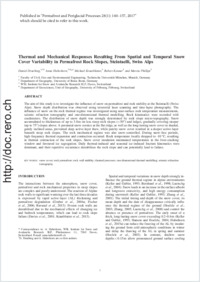Thermal and mechanical responses resulting from spatial and temporal snow cover variability in permafrost rock slopes, steintaelli, swiss alps
- Draebing, Daniel Faculty of Civil, Geo and Environmental Engineering, Technische Universität München, Germany - Department of Geography, University of Bonn, Germany
- Haberkorn, Anna WSL Institute for Snow and Avalanche Research SLF, Davos, Switzerland - Department of Geosciences, Unit of Geography, University of Fribourg, Switzerland
- Krautblatter, Michael Faculty of Civil, Geo and Environmental Engineering, Technische Universität München, Germany
- Kenner, Robert WSL Institute for Snow and Avalanche Research SLF, Davos, Switzerland
- Phillips, Marcia WSL Institute for Snow and Avalanche Research SLF, Davos, Switzerland
-
01.01.2017
Published in:
- Permafrost and Periglacial Processes. - 2017, vol. 28, no. 1, p. 140–157
snow cover
rock permafrost
rock wall stability
thermal processes
one-dimensional thermal modelling
seismic refraction tomography
English
The aim of this study is to investigate the influence of snow on permafrost and rock stability at the Steintaelli (Swiss Alps). Snow depth distribution was observed using terrestrial laser scanning and time-lapse photography. The influence of snow on the rock thermal regime was investigated using near-surface rock temperature measurements, seismic refraction tomography and one-dimensional thermal modelling. Rock kinematics were recorded with crackmeters. The distribution of snow depth was strongly determined by rock slope micro-topography. Snow accumulated to thicknesses of up to 3.8 m on less steep rock slopes (<50°) and ledges, gradually covering steeper (up to 75°) slopes above. A perennial snow cornice at the flat ridge, as well as the long-lasting snow cover in shaded, gently inclined areas, prevented deep active-layer thaw, while patchy snow cover resulted in a deeper active-layer beneath steep rock slopes. The rock mechanical regime was also snow-controlled. During snow-free periods, high-frequency thermal expansion and contraction occurred. Rock temperature locally dropped to -10 °C, resulting in thermal contraction of the rock slopes. Snow cover insulation maintained temperatures in the frost- cracking window and favoured ice segregation. Daily thermal-induced and seasonal ice-induced fracture kinematics were dominant, and their repetitive occurrence destabilises the rock slope and can potentially lead to failure.
- Faculty
- Faculté des sciences et de médecine
- Department
- Département de Géosciences
- Language
-
- English
- Classification
- Hydrology
- License
- License undefined
- Identifiers
-
- RERO DOC 288640
- DOI 10.1002/ppp.1921
- Persistent URL
- https://folia.unifr.ch/unifr/documents/305472
Statistics
Document views: 55
File downloads:
- hab_tmr.pdf: 312
